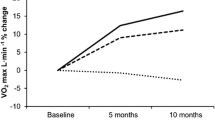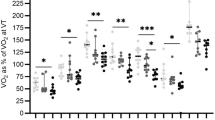Abstract
Current exercise prescription guidelines for children recommend at least 60 min of moderate-to-vigorous physical activity every day. However, little is known about the efficacy of different cardiorespiratory exercise modalities prescribed to the pediatric cohort. Sixteen healthy children (8–12 years) completed 5-min trials of treadmill walking, cycling, and elliptical training in a randomized order. The treadmill walking speed was determined from measurements collected during a self-selected walking trial. The workloads for treadmill walking, cycling, and elliptical training were matched (40.3 W). Mechanical efficiency (ME%), perceived exertion (RPE), oxygen uptake, metabolic equivalents, and net energy expenditure were measured. ME% in walking was significantly higher than in cycling (P = 0.001) and elliptical training (P < 0.001), and cycling was significantly higher than elliptical training (P = 0.003). RPE in walking was significantly lower than in elliptical training (P = 0.006) but not from cycling (P = 0.314), and cycling resulted in significantly lower RPE than elliptical training (P = 0.021). Conclusion: Treadmill walking appears to be the most efficacious exercise prescription for otherwise healthy children; however, longitudinal studies need to be implemented to investigate the long-term benefits of each exercise modality.


Similar content being viewed by others
References
Batte AL, Darling J, Evans J, Lance LM, Olson EI, Pincivero DM (2003) Physiologic response to a prescribed rating of perceived exertion on an elliptical fitness cross-trainer. J Sports Med Phys Fitness 43(3):300–305
Cawley J (2010) The economics of childhood obesity. Health Aff (Millwood) 29(3):364–371
CDC (2008) Physical activity guidelines for Americans. U.S. Department of Health and Human Services, Washington, DC
Donnelly JE, Greene JL, Gibson CA, Smith BK, Washburn RA, Sullivan DK, DuBose K, Mayo MS, Schmelzle KH, Ryan JJ, Jacobsen DJ, Williams SL (2009) Physical activity across the curriculum (PAAC): a randomized controlled trial to promote physical activity and diminish overweight and obesity in elementary school children. Prev Med 49(4):336–34
DuBose KD, Eisenmann JC, Donnelly JE (2007) Aerobic fitness attenuates the metabolic syndrome score in normal-weight, at-risk-for-overweight, and overweight children. Pediatrics 120(5):e1262–1268
Eston G, Parfitt G (2006) Percieved exertion. In: Armstrong N (ed) Paediatric exercise physiology. Elsevier, London, pp 275–297
Faulkner J, Parfitt G, Eston R (2008) The rating of perceived exertion during competitive running scales with time. Psychophysiology 45(6):977–985
Ferguson MA, Gutin B, Le NA, Karp W, Litaker M, Humphries M, Okuyama T, Riggs S, Owens S (1999) Effects of exercise training and its cessation on components of the insulin resistance syndrome in obese children. Int J Obes Relat Metab Disord 23(8):889–895
Fowler EG, Knutson LM, Demuth SK, Siebert KL, Simms VD, Sugi MH, Souza RB, Karim R, Azen SP, Physical Therapy Clinical Research N (2010) Pediatric endurance and limb strengthening (PEDALS) for children with cerebral palsy using stationary cycling: a randomized controlled trial. Phys Ther 90(3):367–381
Glass SC, Knowlton RG, Becque MD (1992) Accuracy of RPE from graded exercise to establish exercise training intensity. Med Sci Sports Exerc 24(11):1303–1307
Gosselink R, Troosters T, Decramer M (1996) Peripheral muscle weakness contributes to exercise limitation in COPD. Am J Respir Crit Care Med 153(3):976–980
Hardin DS, Hebert JD, Bayden T, Dehart M, Mazur L (1997) Treatment of childhood syndrome X. Pediatrics 100(2):E5
Jackson DM, Pace L, Speakman JR (2007) The measurement of resting metabolic rate in preschool children. Obesity (Silver Spring) 15(8):1930–1932
Kelly AS, Wetzsteon RJ, Kaiser DR, Steinberger J, Bank AJ, Dengel DR (2004) Inflammation, insulin, and endothelial function in overweight children and adolescents: the role of exercise. J Pediatr 145(6):731–736
LaForgia J, Withers RT, Gore CJ (2006) Effects of exercise intensity and duration on the excess post-exercise oxygen consumption. J Sports Sci 24(12):1247–1264
Lambourne P, Donnelly JE (2011) The role of physical activity in pediatric Obesity. EdD Pediatr Clin N Am 58:1481–1491
Lochte L, Angermann M, Larsson B (2009) Cardiorespiratory fitness of asthmatic children and validation of predicted aerobic capacity. Clin Respir J 3(1):42–50
Mellecker RR, McManus AM (2009) Measurement of resting energy expenditure in healthy children. JPEN J Parenter Enter Nutr 33(6):640–645
Mendoza JA, Zimmerman FJ, Christakis DA (2007) Television viewing, computer use, obesity, and adiposity in US preschool children. Int J Behav Nutr Phys Act 4:44
Mitchell JA, Pate RR, Dowda M, Mattocks C, Riddoch C, Ness AR, Blair SN (2012) A prospective study of sedentary behavior in a large cohort of youth. Med Sci Sports Exerc 44(6):1081–1087
Morgan DW, Tseh W, Caputo JL, Keefer DJ, Craig IS, Griffith KB, Akins MB, Griffith GE, Krahenbuhl GS, Martin PE (2004) Longitudinal stratification of gait economy in young boys and girls: the locomotion energy and growth study. Eur J Appl Physiol 91(1):30–34
NASPE (2004) Physical activity for children: a statement of guidelines for children ages 5–12. National Association for Sport and Physical Education, Reston
Norman AC, Drinkard B, McDuffie JR, Ghorbani S, Yanoff LB, Yanovski JA (2005) Influence of excess adiposity on exercise fitness and performance in overweight children and adolescents. Pediatrics 115(6):e690–696
O'Donovan G, Blazevich AJ, Boreham C, Cooper AR, Crank H, Ekelund U, Fox KR, Gately P, Giles-Corti B, Gill JM, Hamer M, McDermott I, Murphy M, Mutrie N, Reilly JJ, Saxton JM, Stamatakis E (2010) The ABC of physical activity for health: a consensus statement from the British Association of Sport and Exercise Sciences. J Sports Sci 28(6):573–591
Saibene FB, Minetti AE (2003) Biomechanical and physiological aspects of legged locomotion in humans. Eur J Appl Physiol 88:297–316
Salmon J, Tremblay MS, Marshall SJ, Hume C (2011) Health risks, correlates, and interventions to reduce sedentary behavior in young people. Am J Prev Med 41(2):197–206
Serdula MK, Ivery D, Coates RJ, Freedman DS, Williamson DF, Byers T (1993) Do obese children become obese adults? A review of the literature. Prev Med 22(2):167–177
Shultz SP, Browning RC, Schutz Y, Maffeis C, Hills AP (2011) Childhood obesity and walking: guidelines and challenges. Int J Pediatr Obes 6(5–6):332–341
Stewart A, Marfell-Jones M, Olds T, de Ridder H (2011) International standards for anthropometric assessment. ISAK, Lower Hutt
Strong WB, Malina RM, Blimkie CJ, Daniels SR, Dishman RK, Gutin B, Hergenroeder AC, Must A, Nixon PA, Pivarnik JM, Rowland T, Trost S, Trudeau F (2005) Evidence based physical activity for school-age youth. J Pediatr 146(6):732–737
Taylor RW, Williams SM, Grant AM, Taylor BJ, Goulding A (2011) Predictive ability of waist-to-height in relation to adiposity in children is not improved with age and sex-specific values. Obesity (Silver Spring) 19(5):1062–1068
Timmons BW, Proudfoot NA, MacDonald MJ, Bray SR, Cairney J (2012) The health outcomes and physical activity in preschoolers (HOPP) study: rationale and design. BMC Publ Health 12:284
Tolfrey K, Campbell IG, Batterham AM (1998) Exercise training induced alterations in prepubertal children’s lipid-lipoprotein profile. Med Sci Sports Exerc 30(12):1684–1692
Trasande L, Chatterjee S (2009) The impact of obesity on health service utilization and costs in childhood. Obesity (Silver Spring) 17(9):1749–1754
Weir JB (1990) New methods for calculating metabolic rate with special reference to protein metabolism. 1949. Nutrition 6(3):213–221
WHO (2010) Global recommendations on physical activity and health. World Health Organisation, Geneva
Williams CL, Hayman LL, Daniels SR, Robinson TN, Steinberger J, Paridon S, Bazzarre T (2002) Cardiovascular health in childhood: a statement for health professionals from the Committee on Atherosclerosis, Hypertension, and Obesity in the Young (AHOY) of the Council on Cardiovascular Disease in the Young, American Heart Association. Circulation 106(1):143–160
Zimmerman FJ, Christakis DA, Meltzoff AN (2007) Television and DVD/video viewing in children younger than 2 years. Arch Pediatr Adolesc Med 161(5):473–479
Author information
Authors and Affiliations
Corresponding author
Rights and permissions
About this article
Cite this article
Verweij, B.G.F., Stoner, L. & Shultz, S.P. Exercise modality and metabolic efficiency in children. Eur J Pediatr 172, 1191–1196 (2013). https://doi.org/10.1007/s00431-013-2025-4
Received:
Revised:
Accepted:
Published:
Issue Date:
DOI: https://doi.org/10.1007/s00431-013-2025-4




